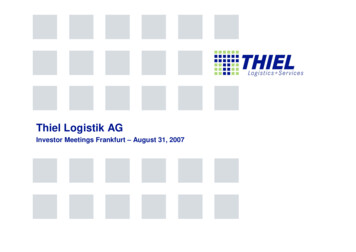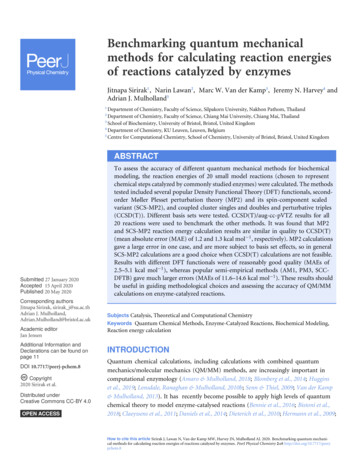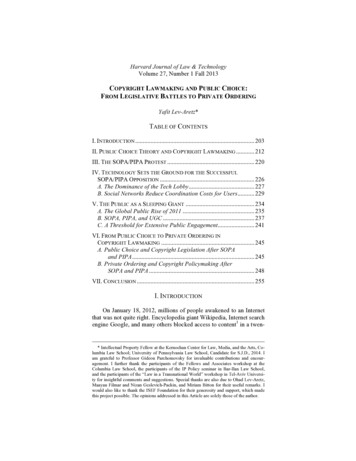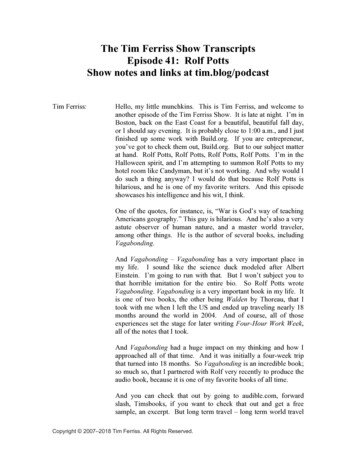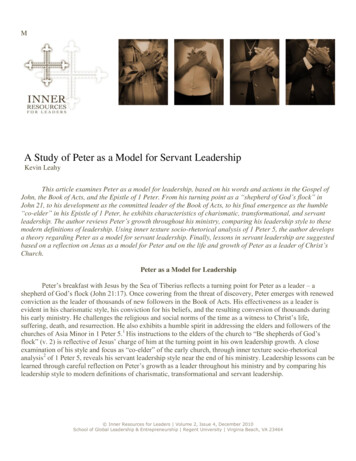
Transcription
Copyright 2014 by Peter ThielAll rights reserved.Published in the United States by Crown Business, an imprint of the Crown Publishing Group, a division of Random House LLC, aPenguin Random House Company, New York.www.crownpublishing.comCROWN BUSINESSis a trademark and CROWN and the Rising Sun colophon are registered trademarks of Random House LLC.Crown Business books are available at special discounts for bulk purchases for sales promotions or corporate use. Special editions,including personalized covers, excerpts of existing books, or books with corporate logos, can be created in large quantities for specialneeds. For more information, contact Premium Sales at (212) 572-2232 or e-mail specialmarkets@randomhouse.com.Library of Congress Cataloging-in-Publication DataThiel, Peter A.Zero to one: notes on startups, or how to build the future / Peter Thiel with Blake Masters.pages cm1. New business enterprises. 2. New products. 3. Entrepreneurship. 4. Diffusion of innovations. I. Title.HD62.5.T525 2014685.11—dc232014006653Hardcover ISBN: 978-0-8041-3929-8eBook ISBN: 978-0-8041-3930-4Book design by Ralph Fowler / rlfdesignGraphics by Rodrigo Corral DesignIllustrations by Matt BuckCover design by Michael NaginAdditional credits appear on this page, which constitutes a continuation of this copyright page.v3.1
ContentsPreface: Zero to One1 The Challenge of the Future2 Party Like It’s 19993 All Happy Companies Are Different4 The Ideology of Competition5 Last Mover Advantage6 You Are Not a Lottery Ticket7 Follow the Money8 Secrets9 Foundations10 The Mechanics of Mafia11 If You Build It, Will They Come?12 Man and Machine13 Seeing Green14 The Founder’s ParadoxConclusion: Stagnation or Singularity?AcknowledgmentsIllustration CreditsIndexAbout the Authors
PrefaceZERO TO ONEEhappens only once. The next Bill Gates will not build an operating system. The nextLarry Page or Sergey Brin won’t make a search engine. And the next Mark Zuckerberg won’t create asocial network. If you are copying these guys, you aren’t learning from them.Of course, it’s easier to copy a model than to make something new. Doing what we already knowhow to do takes the world from 1 to n, adding more of something familiar. But every time we createsomething new, we go from 0 to 1. The act of creation is singular, as is the moment of creation, andthe result is something fresh and strange.Unless they invest in the difficult task of creating new things, American companies will fail in thefuture no matter how big their profits remain today. What happens when we’ve gained everything tobe had from fine-tuning the old lines of business that we’ve inherited? Unlikely as it sounds, theanswer threatens to be far worse than the crisis of 2008. Today’s “best practices” lead to dead ends;the best paths are new and untried.In a world of gigantic administrative bureaucracies both public and private, searching for a newpath might seem like hoping for a miracle. Actually, if American business is going to succeed, we aregoing to need hundreds, or even thousands, of miracles. This would be depressing but for one crucialfact: humans are distinguished from other species by our ability to work miracles. We call thesemiracles technology.Technology is miraculous because it allows us to do more with less, ratcheting up our fundamentalcapabilities to a higher level. Other animals are instinctively driven to build things like dams orhoneycombs, but we are the only ones that can invent new things and better ways of making them.Humans don’t decide what to build by making choices from some cosmic catalog of options given inadvance; instead, by creating new technologies, we rewrite the plan of the world. These are the kindof elementary truths we teach to second graders, but they are easy to forget in a world where so muchof what we do is repeat what has been done before.Zero to One is about how to build companies that create new things. It draws on everything I’velearned directly as a co-founder of PayPal and Palantir and then an investor in hundreds of startups,including Facebook and SpaceX. But while I have noticed many patterns, and I relate them here, thisbook offers no formula for success. The paradox of teaching entrepreneurship is that such a formulanecessarily cannot exist; because every innovation is new and unique, no authority can prescribe inconcrete terms how to be innovative. Indeed, the single most powerful pattern I have noticed is thatsuccessful people find value in unexpected places, and they do this by thinking about business fromfirst principles instead of formulas.This book stems from a course about startups that I taught at Stanford in 2012. College students canbecome extremely skilled at a few specialties, but many never learn what to do with those skills inthe wider world. My primary goal in teaching the class was to help my students see beyond the trackslaid down by academic specialties to the broader future that is theirs to create. One of those students,VERY MOMENT IN BUSINESS
Blake Masters, took detailed class notes, which circulated far beyond the campus, and in Zero to OneI have worked with him to revise the notes for a wider audience. There’s no reason why the futureshould happen only at Stanford, or in college, or in Silicon Valley.
1
THE CHALLENGE OF THE FUTUREWIsomeone for a job, I like to ask this question: “What important truth do very fewpeople agree with you on?”This question sounds easy because it’s straightforward. Actually, it’s very hard to answer. It’sintellectually difficult because the knowledge that everyone is taught in school is by definition agreedupon. And it’s psychologically difficult because anyone trying to answer must say something sheknows to be unpopular. Brilliant thinking is rare, but courage is in even shorter supply than genius.Most commonly, I hear answers like the following:HENEVERINTERVIEW“Our educational system is broken and urgently needs to be fixed.”“America is exceptional.”“There is no God.”Those are bad answers. The first and the second statements might be true, but many people alreadyagree with them. The third statement simply takes one side in a familiar debate. A good answer takesthe following form: “Most people believe in x, but the truth is the opposite of x.” I’ll give my ownanswer later in this chapter.What does this contrarian question have to do with the future? In the most minimal sense, the futureis simply the set of all moments yet to come. But what makes the future distinctive and important isn’tthat it hasn’t happened yet, but rather that it will be a time when the world looks different from today.In this sense, if nothing about our society changes for the next 100 years, then the future is over 100years away. If things change radically in the next decade, then the future is nearly at hand. No one canpredict the future exactly, but we know two things: it’s going to be different, and it must be rooted intoday’s world. Most answers to the contrarian question are different ways of seeing the present; goodanswers are as close as we can come to looking into the future.
ZERO TO ONE: THE FUTURE OF PROGRESSWhen we think about the future, we hope for a future of progress. That progress can take one of twoforms. Horizontal or extensive progress means copying things that work—going from 1 to n.Horizontal progress is easy to imagine because we already know what it looks like. Vertical orintensive progress means doing new things—going from 0 to 1. Vertical progress is harder to imaginebecause it requires doing something nobody else has ever done. If you take one typewriter and build100, you have made horizontal progress. If you have a typewriter and build a word processor, youhave made vertical progress.At the macro level, the single word for horizontal progress is globalization—taking things thatwork somewhere and making them work everywhere. China is the paradigmatic example ofglobalization; its 20-year plan is to become like the United States is today. The Chinese have beenstraightforwardly copying everything that has worked in the developed world: 19th-century railroads,20th-century air conditioning, and even entire cities. They might skip a few steps along the way—going straight to wireless without installing landlines, for instance—but they’re copying all the same.The single word for vertical, 0 to 1 progress is technology. The rapid progress of informationtechnology in recent decades has made Silicon Valley the capital of “technology” in general. Butthere is no reason why technology should be limited to computers. Properly understood, any new andbetter way of doing things is technology.
Because globalization and technology are different modes of progress, it’s possible to have both,either, or neither at the same time. For example, 1815 to 1914 was a period of both rapidtechnological development and rapid globalization. Between the First World War and Kissinger’strip to reopen relations with China in 1971, there was rapid technological development but not muchglobalization. Since 1971, we have seen rapid globalization along with limited technologicaldevelopment, mostly confined to IT.This age of globalization has made it easy to imagine that the decades ahead will bring moreconvergence and more sameness. Even our everyday language suggests we believe in a kind oftechnological end of history: the division of the world into the so-called developed and developingnations implies that the “developed” world has already achieved the achievable, and that poorernations just need to catch up.But I don’t think that’s true. My own answer to the contrarian question is that most people think thefuture of the world will be defined by globalization, but the truth is that technology matters more.Without technological change, if China doubles its energy production over the next two decades, itwill also double its air pollution. If every one of India’s hundreds of millions of households were tolive the way Americans already do—using only today’s tools—the result would be environmentallycatastrophic. Spreading old ways to create wealth around the world will result in devastation, notriches. In a world of scarce resources, globalization without new technology is unsustainable.New technology has never been an automatic feature of history. Our ancestors lived in static, zerosum societies where success meant seizing things from others. They created new sources of wealthonly rarely, and in the long run they could never create enough to save the average person from anextremely hard life. Then, after 10,000 years of fitful advance from primitive agriculture to medievalwindmills and 16th-century astrolabes, the modern world suddenly experienced relentlesstechnological progress from the advent of the steam engine in the 1760s all the way up to about 1970.As a result, we have inherited a richer society than any previous generation would have been able toimagine.Any generation excepting our parents’ and grandparents’, that is: in the late 1960s, they expected
this progress to continue. They looked forward to a four-day workweek, energy too cheap to meter,and vacations on the moon. But it didn’t happen. The smartphones that distract us from oursurroundings also distract us from the fact that our surroundings are strangely old: only computers andcommunications have improved dramatically since midcentury. That doesn’t mean our parents werewrong to imagine a better future—they were only wrong to expect it as something automatic. Todayour challenge is to both imagine and create the new technologies that can make the 21st century morepeaceful and prosperous than the 20th.
STARTUP THINKINGNew technology tends to come from new ventures—startups. From the Founding Fathers in politics tothe Royal Society in science to Fairchild Semiconductor’s “traitorous eight” in business, smallgroups of people bound together by a sense of mission have changed the world for the better. Theeasiest explanation for this is negative: it’s hard to develop new things in big organizations, and it’seven harder to do it by yourself. Bureaucratic hierarchies move slowly, and entrenched interests shyaway from risk. In the most dysfunctional organizations, signaling that work is being done becomes abetter strategy for career advancement than actually doing work (if this describes your company, youshould quit now). At the other extreme, a lone genius might create a classic work of art or literature,but he could never create an entire industry. Startups operate on the principle that you need to workwith other people to get stuff done, but you also need to stay small enough so that you actually can.Positively defined, a startup is the largest group of people you can convince of a plan to build adifferent future. A new company’s most important strength is new thinking: even more important thannimbleness, small size affords space to think. This book is about the questions you must ask andanswer to succeed in the business of doing new things: what follows is not a manual or a record ofknowledge but an exercise in thinking. Because that is what a startup has to do: question receivedideas and rethink business from scratch.
2
PARTY LIKE IT’S 1999O—What important truth do very few people agree with you on?—is difficult toanswer directly. It may be easier to start with a preliminary: what does everybody agree on?“Madness is rare in individuals—but in groups, parties, nations, and ages it is the rule,” Nietzschewrote (before he went mad). If you can identify a delusional popular belief, you can find what lieshidden behind it: the contrarian truth.Consider an elementary proposition: companies exist to make money, not to lose it. This should beobvious to any thinking person. But it wasn’t so obvious to many in the late 1990s, when no loss wastoo big to be described as an investment in an even bigger, brighter future. The conventional wisdomof the “New Economy” accepted page views as a more authoritative, forward-looking financialmetric than something as pedestrian as profit.Conventional beliefs only ever come to appear arbitrary and wrong in retrospect; whenever onecollapses, we call the old belief a bubble. But the distortions caused by bubbles don’t disappearwhen they pop. The internet craze of the ’90s was the biggest bubble since the crash of 1929, and thelessons learned afterward define and distort almost all thinking about technology today. The first stepto thinking clearly is to question what we think we know about the past.UR CONTRARIAN QUESTION
A QUICK HISTORY OF THE ’90SThe 1990s have a good image. We tend to remember them as a prosperous, optimistic decade thathappened to end with the internet boom and bust. But many of those years were not as cheerful as ournostalgia holds. We’ve long since forgotten the global context for the 18 months of dot-com mania atdecade’s end.The ’90s started with a burst of euphoria when the Berlin Wall came down in November ’89. Itwas short-lived. By mid-1990, the United States was in recession. Technically the downturn ended inMarch ’91, but recovery was slow and unemployment continued to rise until July ’92. Manufacturingnever fully rebounded. The shift to a service economy was protracted and painful.1992 through the end of 1994 was a time of general malaise. Images of dead American soldiers inMogadishu looped on cable news. Anxiety about globalization and U.S. competitiveness intensifiedas jobs flowed to Mexico. This pessimistic undercurrent drove then-president Bush 41 out of officeand won Ross Perot nearly 20% of the popular vote in ’92—the best showing for a third-partycandidate since Theodore Roosevelt in 1912. And whatever the cultural fascination with Nirvana,grunge, and heroin reflected, it wasn’t hope or confidence.Silicon Valley felt sluggish, too. Japan seemed to be winning the semiconductor war. The internethad yet to take off, partly because its commercial use was restricted until late 1992 and partly due tothe lack of user-friendly web browsers. It’s telling that when I arrived at Stanford in 1985,economics, not computer science, was the most popular major. To most people on campus, the techsector seemed idiosyncratic or even provincial.The internet changed all this. The Mosaic browser was officially released in November 1993,giving regular people a way to get online. Mosaic became Netscape, which released its Navigatorbrowser in late 1994. Navigator’s adoption grew so quickly—from about 20% of the browser marketin January 1995 to almost 80% less than 12 months later—that Netscape was able to IPO in August’95 even though it wasn’t yet profitable. Within five months, Netscape stock had shot up from 28 to 174 per share. Other tech companies were booming, too. Yahoo! went public in April ’96 with an 848 million valuation. Amazon followed suit in May ’97 at 438 million. By spring of ’98, eachcompany’s stock had more than quadrupled. Skeptics questioned earnings and revenue multipleshigher than those for any non-internet company. It was easy to conclude that the market had gonecrazy.This conclusion was understandable but misplaced. In December ’96—more than three yearsbefore the bubble actually burst—Fed chairman Alan Greenspan warned that “irrational exuberance”might have “unduly escalated asset values.” Tech investors were exuberant, but it’s not clear that theywere so irrational. It is too easy to forget that things weren’t going very well in the rest of the worldat the time.The East Asian financial crises hit in July 1997. Crony capitalism and massive foreign debtbrought the Thai, Indonesian, and South Korean economies to their knees. The ruble crisis followedin August ’98 when Russia, hamstrung by chronic fiscal deficits, devalued its currency and defaultedon its debt. American investors grew nervous about a nation with 10,000 nukes and no money; theDow Jones Industrial Average plunged more than 10% in a matter of days.People were right to worry. The ruble crisis set off a chain reaction that brought down Long-TermCapital Management, a highly leveraged U.S. hedge fund. LTCM managed to lose 4.6 billion in thelatter half of 1998, and still had over 100 billion in liabilities when the Fed intervened with amassive bailout and slashed interest rates in order to prevent systemic disaster. Europe wasn’t doing
that much better. The euro launched in January 1999 to great skepticism and apathy. It rose to 1.19on its first day of trading but sank to 0.83 within two years. In mid-2000, G7 central bankers had toprop it up with a multibillion-dollar intervention.So the backdrop for the short-lived dot-com mania that started in September 1998 was a world inwhich nothing else seemed to be working. The Old Economy couldn’t handle the challenges ofglobalization. Something needed to work—and work in a big way—if the future was going to bebetter at all. By indirect proof, the New Economy of the internet was the only way forward.
MANIA: SEPTEMBER 1998–MARCH 2000Dot-com mania was intense but short—18 months of insanity from September 1998 to March 2000. Itwas a Silicon Valley gold rush: there was money everywhere, and no shortage of exuberant, oftensketchy people to chase it. Every week, dozens of new startups competed to throw the most lavishlaunch party. (Landing parties were much more rare.) Paper millionaires would rack up thousanddollar dinner bills and try to pay with shares of their startup’s stock—sometimes it even worked.Legions of people decamped from their well-paying jobs to found or join startups. One 40-somethinggrad student that I knew was running six different companies in 1999. (Usually, it’s considered weirdto be a 40-year-old graduate student. Usually, it’s considered insane to start a half-dozen companiesat once. But in the late ’90s, people could believe that was a winning combination.) Everybodyshould have known that the mania was unsustainable; the most “successful” companies seemed toembrace a sort of anti-business model where they lost money as they grew. But it’s hard to blamepeople for dancing when the music was playing; irrationality was rational given that appending“.com” to your name could double your value overnight.
PAYPAL MANIAWhen I was running PayPal in late 1999, I was scared out of my wits—not because I didn’t believe inour company, but because it seemed like everyone else in the Valley was ready to believe anything atall. Everywhere I looked, people were starting and flipping companies with alarming casualness. Oneacquaintance told me how he had planned an IPO from his living room before he’d even incorporatedhis company—and he didn’t think that was weird. In this kind of environment, acting sanely began toseem eccentric.At least PayPal had a suitably grand mission—the kind that post-bubble skeptics would laterdescribe as grandiose: we wanted to create a new internet currency to replace the U.S. dollar. Ourfirst product let people beam money from one PalmPilot to another. However, nobody had any use forthat product except the journalists who voted it one of the 10 worst business ideas of 1999.PalmPilots were still too exotic then, but email was already commonplace, so we decided to create away to send and receive payments over email.By the fall of ’99, our email payment product worked well—anyone could log in to our websiteand easily transfer money. But we didn’t have enough customers, growth was slow, and expensesmounted. For PayPal to work, we needed to attract a critical mass of at least a million users.Advertising was too ineffective to justify the cost. Prospective deals with big banks kept fallingthrough. So we decided to pay people to sign up.We gave new customers 10 for joining, and we gave them 10 more every time they referred afriend. This got us hundreds of thousands of new customers and an exponential growth rate. Ofcourse, this customer acquisition strategy was unsustainable on its own—when you pay people to beyour customers, exponential growth means an exponentially growing cost structure. Crazy costs weretypical at that time in the Valley. But we thought our huge costs were sane: given a large user base,PayPal had a clear path to profitability by taking a small fee on customers’ transactions.We knew we’d need more funding to reach that goal. We also knew that the boom was going toend. Since we didn’t expect investors’ faith in our mission to survive the coming crash, we movedfast to raise funds while we could. On February 16, 2000, the Wall Street Journal ran a story laudingour viral growth and suggesting that PayPal was worth 500 million. When we raised 100 millionthe next month, our lead investor took the Journal’s back-of-the-envelope valuation as authoritative.(Other investors were in even more of a hurry. A South Korean firm wired us 5 million without firstnegotiating a deal or signing any documents. When I tried to return the money, they wouldn’t tell mewhere to send it.) That March 2000 financing round bought us the time we needed to make PayPal asuccess. Just as we closed the deal, the bubble popped.
LESSONS LEARNED’Cause they say 2,000 zero zero party over, oops! Out of time!So tonight I’m gonna party like it’s 1999!—PRINCEThe NASDAQ reached 5,048 at its peak in the middle of March 2000 and then crashed to 3,321 in themiddle of April. By the time it bottomed out at 1,114 in October 2002, the country had long sinceinterpreted the market’s collapse as a kind of divine judgment against the technological optimism ofthe ’90s. The era of cornucopian hope was relabeled as an era of crazed greed and declared to bedefinitely over.Everyone learned to treat the future as fundamentally indefinite, and to dismiss as an extremistanyone with plans big enough to be measured in years instead of quarters. Globalization replacedtechnology as the hope for the future. Since the ’90s migration “from bricks to clicks” didn’t work ashoped, investors went back to bricks (housing) and BRICs (globalization). The result was anotherbubble, this time in real estate.The entrepreneurs who stuck with Silicon Valley learned four big lessons from the dot-com crashthat still guide business thinking today:
1. Make incremental advancesGrand visions inflated the bubble, so they should not be indulged. Anyone who claims to be ableto do something great is suspect, and anyone who wants to change the world should be morehumble. Small, incremental steps are the only safe path forward.2. Stay lean and flexibleAll companies must be “lean,” which is code for “unplanned.” You should not know what yourbusiness will do; planning is arrogant and inflexible. Instead you should try things out, “iterate,”and treat entrepreneurship as agnostic experimentation.3. Improve on the competitionDon’t try to create a new market prematurely. The only way to know you have a real business isto start with an already existing customer, so you should build your company by improving onrecognizable products already offered by successful competitors.4. Focus on product, not salesIf your product requires advertising or salespeople to sell it, it’s not good enough: technology isprimarily about product development, not distribution. Bubble-era advertising was obviouslywasteful, so the only sustainable growth is viral growth.These lessons have become dogma in the startup world; those who would ignore them arepresumed to invite the justified doom visited upon technology in the great crash of 2000. And yet theopposite principles are probably more correct:1. It is better to risk boldness than triviality.2. A bad plan is better than no plan.3. Competitive markets destroy profits.4. Sales matters just as much as product.It’s true that there was a bubble in technology. The late ’90s was a time of hubris: people believedin going from 0 to 1. Too few startups were actually getting there, and many never went beyondtalking about it. But people understood that we had no choice but to find ways to do more with less.The market high of March 2000 was obviously a peak of insanity; less obvious but more important, itwas also a peak of clarity. People looked far into the future, saw how much valuable new technologywe would need to get there safely, and judged themselves capable of creating it.We still need new technology, and we may even need some 1999-style hubris and exuberance toget it. To build the next generation of companies, we must abandon the dogmas created after the crash.That doesn’t mean the opposite ideas are automatically true: you can’t escape the madness of crowdsby dogmatically rejecting them. Instead ask yourself: how much of what you know about business isshaped by mistaken reactions to past mistakes? The most contrarian thing of all is not to oppose thecrowd but to think for yourself.
3
ALL HAPPY COMPANIES ARE DIFFERENTTof our contrarian question is: what valuable company is nobody building? Thisquestion is harder than it looks, because your company could create a lot of value without becomingvery valuable itself. Creating value is not enough—you also need to capture some of the value youcreate.This means that even very big businesses can be bad businesses. For example, U.S. airlinecompanies serve millions of passengers and create hundreds of billions of dollars of value each year.But in 2012, when the average airfare each way was 178, the airlines made only 37 cents perpassenger trip. Compare them to Google, which creates less value but captures far more. Googlebrought in 50 billion in 2012 (versus 160 billion for the airlines), but it kept 21% of those revenuesas profits—more than 100 times the airline industry’s profit margin that year. Google makes so muchmoney that it’s now worth three times more than every U.S. airline combined.The airlines compete with each other, but Google stands alone. Economists use two simplifiedmodels to explain the difference: perfect competition and monopoly.“Perfect competition” is considered both the ideal and the default state in Economics 101. Socalled perfectly competitive markets achieve equilibrium when producer supply meets consumerdemand. Every firm in a competitive market is undifferentiated and sells the same homogeneousproducts. Since no firm has any market power, they must all sell at whatever price the marketdetermines. If there is money to be made, new firms will enter the market, increase supply, driveprices down, and thereby eliminate the profits that attracted them in the first place. If too many firmsenter the market, they’ll suffer losses, some will fold, and prices will rise back to sustainable levels.Under perfect competition, in the long run no company makes an economic profit.The opposite of perfect competition is monopoly. Whereas a competitive firm must sell at themarket price, a monopoly owns its market, so it can set its own prices. Since it has no competition, itproduces at the quantity and price combination that maximizes its profits.To an economist, every monopoly looks the same, whether it deviously eliminates rivals, secures alicense from the state, or innovates its way to the top. In this book, we’re not interested in illegalbullies or government favorites: by “monopoly,” we mean the kind of company that’s so good at whatit does that no other firm can offer a close substitute. Google is a good example of a company thatwent from 0 to 1: it hasn’t competed in search since the early 2000s, when it definitively distanceditself from Microsoft and Yahoo!Americans mythologize competition and credit it with saving us from socialist bread lines.Actually, capitalism and competition are opposites. Capitalism is premised on the accumulation ofcapital, but under perfect competition all profits get competed away. The lesson for entrepreneurs isclear: if you want to create and capture lasting value, don’t build an undifferentiated commoditybusiness.HE BUSINESS VERSION
LIES PEOPLE TELLHow much of the world is
eBook ISBN: 978-0-8041-3930-4 Book design by Ralph Fowler / rlfdesign Graphics by Rodrigo Corral Design Illustrations by Matt Buck Cover design by Michael Nagin Additional credits appear on this page, whic
